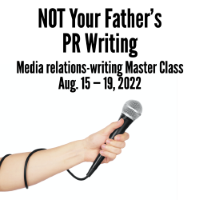Boil your company down with boilerplates
Boilerplates: Can’t live with ’em, can’t get a decent one through approvals.

Here are three ways to boil your company down into a great boilerplate:
1. What goes into a good boilerplate?
To decide what to include in your boilerplate, think like your target audience. Ask, “What would a journalist or blogger need to know to define my company in an article or post?”
For the most part, you’ll want to stick to the 5 W’s. Include:
WHOM you help. AllianceBernstein’s boilerplate, for instance, says, “For over 40 years, AllianceBernstein Investments, Inc., … has helped investors …”
WHAT you make or do. AllianceBernstein: “… mutual funds, college savings (529) plans, retirement products and separately managed accounts.”
WHERE you’re located. List your headquarters location and summarize the rest of your locations in a phrase. Also include where readers can find you online:
- Link your company name to your homepage.
- Include the URL in parentheses after your company name: Wylie Communications Inc. (http://www.WylieComm.com) …
- Drop all of your social addresses. They don’t need to know how to find you on Twitter.
WHY you’re an industry leader. Don’t just call yourself a leader. Deliver a compelling proof point.
Rosetta Stone’s boilerplate, for instance, says:
You might also include:
- Your stock ticker symbol
- The year you were founded, if notable. American Express, for instance, notes that it was founded in 1850. Wylie Communications, on the other hand, doesn’t mention that it was founded in 1996.
- Your size in measures that make sense for your organization. That might be in annual revenues; assets under management; number of employees, clients, members, outlets or products sold.
2. What to leave out of your boilerplate
What you take out of your boilerplate is almost as important as what you put in.
So drop the vapid marketing slogans. Skip the marketing fluff. “Innovative investment solutions from a diverse line of investment vehicles,” for instance, gets me nowhere.
If the reader can’t tell what you make or what industry you’re in after reading your boilerplate, go back to Go.
3. Keep boilerplates short.
I’ve seen boilerplates that are as long as 400 words. People: That’s too long for a contemporary news release, let alone the boilerplate.
Instead, keep your boilerplate to 100 words or less. Even better: Keep it under 50 words.
Polish your boilerplate.
Whatever you do, make sure you negotiate a great boilerplate. These things are with us for the long haul.
Because only two things will survive global warming: cockroaches and boilerplates.
How can you get your story picked up?
PR professionals have been married to the traditional news release format since Ivy Lee created the release more than 100 years ago. Why, then, do we need a new approach?
 With 2,500 releases going out each day — that’s one every 35 seconds — the impact of your traditional news release ain’t what it used to be. In fact, fewer than 50% of all traditional news releases ever get covered, according to PR Newswire’s own research.
With 2,500 releases going out each day — that’s one every 35 seconds — the impact of your traditional news release ain’t what it used to be. In fact, fewer than 50% of all traditional news releases ever get covered, according to PR Newswire’s own research.
Learn to put your PR pieces among the 50% that actually get the word out at NOT Your Father’s PR Writing — our media relations-writing workshop starting Aug. 15.
There, you’ll learn current best PR-writing practices. And you’ll improve your writing with personal feedback and coaching from the Public Relations Society of America’s “national writing coach.”
Save upto $100 with our group discounts.
